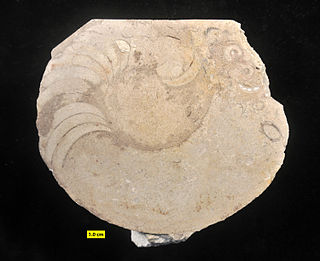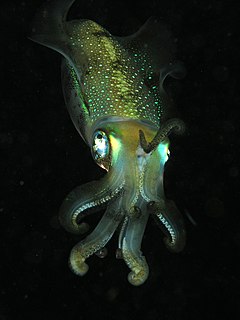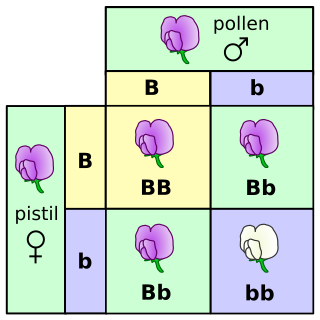
Plectronocerida is a primitive order from which subsequent cephalopod orders are ultimately derived.
The Ellesmerocerida is an order of primitive cephalopods belonging to the subclass Nautiloidea with a widespread distribution that lived during the Late Cambrian and Ordovician.
Trocholites is a tarphycerid genus in the family Trocholitidae from the Middle and Upper Ordovician with a gradually expanding, weakly ribbed shell; whorls in contact, dorsum slightly impressed; cross section depressed, venter and sides rounded; siphuncle close to but not at the dorsal margin.
The Tarphycerida were the first of the coiled cephalopods, found in marine sediments from the Lower Ordovician to the Middle Devonian. Some, such as Aphetoceras and Estonioceras, are loosely coiled and gyroconic; others, such as Campbelloceras, Tarphyceras, and Trocholites, are tightly coiled, but evolute with all whorls showing. The body chamber of tarphycerids is typically long and tubular, as much as half the length of the containing whorl in most, greater than in the Silurian Ophidioceratidae. The Tarphycerida evolved from the elongated, compressed, exogastric Bassleroceratidae, probably Bassleroceras, around the end of the Gasconadian through forms like Aphetoceras. Close coiling developed rather quickly, and both gyroconic and evolute forms are found in the early middle Canadian.
Tarphyeras is a genus of tarphyceratid with whorls rounded in cross section, having a deeply impressed dorsum and a ventral to subcentral siphuncle, known from the Lower Ord of North America. It differs from Campbelloceras in that Campbelloceras is only slightly impressed, from Centrotarphyceras in that Centrotarphyceras is subquadrate and has a central siphuncle, and from Trocholites in that although Trocholites is subcircular in cross section, the siphuncle is subdorsal.
Campbelloceras is a tarphyceratid nautiloid known from the Lower Ordovician, Upper Canadian Epoch of North America, where it is widespread. Campbelloceras was named by Ulrich and Foerste in 1936.
The Tarphyceratidae are tightly coiled, evolute Tarphycerida with ventral siphuncles. The dorsum is characteristically impressed where the whorl presses against the venter of the previous. The Tarphyceratidae are derived from Bassleroceras or possibly from some member of the Estonioceratidae.
The Trocholitidae are Tarphycerida with whorls in close contact as with the Tarphyceratidae, but in which the siphuncle, similar in structure, becomes dorsal. The Trocholitidae are derived from the Tarphyceratidae, perhaps from different tarphyceratids.
Basslerocerida is an order of nautiloid cephalopods from the Ordovician comprising exogastric longiconic cyrtocones, that is no longer in common use.

The Trigonocerataceae are a superfamily within the Nautilida that ranged from the Devonian to the Triassic, thought to have contained the source for the Nautilaceae in which Nautilus is found.
The Bassleroceratidae is a family of gradually expanding, smooth ellesmerocerids with a slight to moderate exogastric curvature, subcircular to strongly compressed cross section, and ventral orthochaonitc siphuncle. The ventral side is typically more sharply rounded than the dorsal side and septa are close spaced. Connecting rings are thick and slightly expanded into the siphuncle, making the segments slightly concave; characteristic of the Ellesmerocerida.
The Centroceratidae is the ancestral family of the Trigonocerataceae and of the equivalent Centroceratina; extinct shelled cephalopods belonging to the order Nautilida
Protcycloceratidae is an extinct family of slender, commonly annulate, members of the cephalopod order Ellesmerocerida that lived during the Early Ordovician.
The Naedyceras group comprises three similar and closely related openly coiled, gyroconic, genera within oncocerid family, Brevicoceratidae: Naedyceras, Gonionaedyceras, and Gyronaedyceras.
Bassleroceras is an elongate upwardly curved, exogastric, genus with the venter on the under side more sharply rounded than the dorsum on the upper. The siphuncle is ventral, composed of thick-walled tubular segments in which connection rings thicken in towardly as in both the Ellesmerocerida and primitive Tarphycerida.
Dakeoceras is a genus of simple cyrtoconic ellesmeroceratid cephalopods in the fossil record. All known species come from the Lower Canadian epoch (Gasconadian) of North America.

The Estonioceratidae are a family of loosely coiled tarphycerids in which the inner side of the whorls, which forms the dorsum, is rounded or flat with no impression, and in which the siphuncle, composed of thick tubular segments, is located ventrally. The Estonioceratidae seem to form a link between the ancestral Bassleroceratidae and the more tightly coiled Tarphyceratidae.
Ophioceras is a genus of closely coiled tarphycerid nautiloid cephalopods, the sole representatives of the family Ophidioceratidae, characterized by an evolute shell with narrow, subrounded, annulated whorls and a subcentral siphuncle composed of thin connecting rings that show no evidence of layering. The mature body chamber is strongly divergent and is the longest proportionally of any tarphycerid. The aperture has a deep hyponomic sinus and ocular sinuses, and so resembles some lituitids.

Goldringia is an extinct nautilid of the Rutoceratidae family that lived during the Middle Devonian. It is known from New York, Ohio, and Indiana in the United States.
Alaskoceras is a genus of lower Ordovician coiled nautiloid cephalopods; the shell moderately expanded, ribbed, with a divergent living chamber; whorl section more broadly rounded ventrally than dorsally; siphuncle marginal at maturity, septal necks short, almost achoanitic; connecting rings thick, layered.






